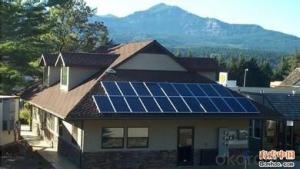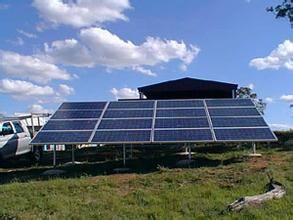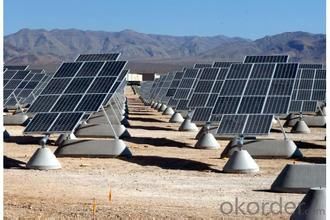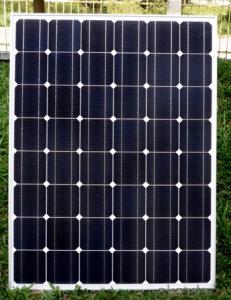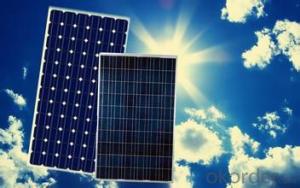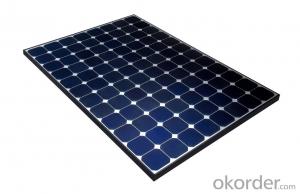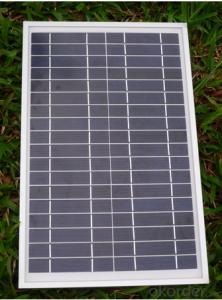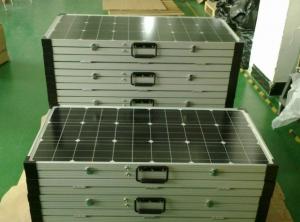Wholesale 80w CNBM Polycrystalline Silicon Solar Panels for Home Use
- Loading Port:
- China main port
- Payment Terms:
- TT OR LC
- Min Order Qty:
- 100 watt
- Supply Capability:
- 1000 watt/month
OKorder Service Pledge
OKorder Financial Service
You Might Also Like
Specification
80W CNBM Polycrystalline Silicon Panel for Home Using
Production description
Most solar modules are currently produced from crystalline silicon (c-Si) solar cells made of multicrystalline andmonocrystalline silicon. In 2013, crystalline silicon accounted for more than 90 percent of worldwide PV production, while the rest of the overall market is made up of thin-film technologies using cadmium telluride, CIGS and amorphous silicon[7]Emerging, third generation solar technologies use advanced thin-film cells. They produce a relatively high-efficiency conversion for the low cost compared to other solar technologies. Also, high-cost, high-efficiency, and close-packed rectangular multi-junction (MJ) cells are preferably used in solar panels on spacecraft, as they offer the highest ratio of generated power per kilogram lifted into space. MJ-cells are compound semiconductors and made of gallium arsenide (GaAs) and other semiconductor materials. Another emerging PV technology using MJ-cells is concentrator photovoltaics (CPV).
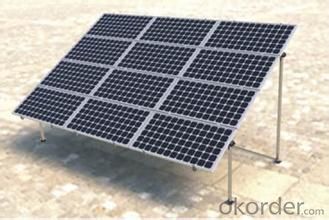
Feature
1.High conversion efficiencies resulting in superior power output performance.
2.Outstanding power output even in low light or high temperature conditions
3.Optimized design for ease of soldering and lamination
4.Long-term stability,reliability and performance
5.Low breakage rate
6.Color uniformaity
Physical characteristic
1. Rigorous quality control meets the highest international standards.
2. High-transmissivity low-iron tempered glass, strong aluminium frame.
3. Using UV-resistant silicon.
4. IS09001/14001/CE/TUV/UL
- Q: I have a shed that has wiring run for light bulb and a couple outlets. It is in a dark corner of my yard and at night is kinda creepy to go in with even a flashlight. I am weighing the option/expense of running electricity from the house on an overhead line versus putting up a 45 watt solar panel on the metal roof with inverter, battery etc. Sunlight is good to excellent at the location. Question is - will this be sufficient for the occasional use of light and an outlet? What can I expect? Pros and cons appreciated
- For okorder /... Electric power. Rather than an overhead cable you can bury a cable or PVC conduit and power the shed with 20AC. You can easily supply 5 to 30A of 20V AC that supply all of your power needs without the issues and limitations of the Solar system. If your shed is within 200 ft of your home you should be able to power the shed for less than $400 if you do the work.
- Q: And I'm tring to decide if I should buy it. Let's say my house would need Megawatt per hour. That's 000 megawatts per hour. This solar panel produces 36 watts. I don't know how if that means per hour or what???
- Build okorder /
- Q: . Does it really only cost $200 in contrast to $5000 or more?2. How much would it cost to build panels that would energize an entire average household? (washer, dryer, water heater, lights, fans, a/c)3. Is there a place to get the info on how to make them for free instead of paying E4E?4. Are the professional solar panels better? more efficient? 5. Will the electric company in So. Cal. really pay you?6. Do you have to be certified to do this professionally? or an electrician? If so what schools teach it?7. Would wind generators be of any use in So. Cal.? I mean don't you really need to get the fan spinning to get energy?8. Are there any extra unseen costs? (tools, energy converter, ect)9. How much is it to get an electrician to hook you to the grid?0. Is it better to hook to batteries or the grid? Pros, cons, why?
- Question# 5: Any state in the USA is entitle to a Federal Tax credit on their Income tax returns. Click on the source for details.
- Q: How much electricity can a solar panel produce?
- The amount of electricity a solar panel can produce depends on various factors such as the size and efficiency of the panel, the amount of sunlight it receives, and the location. On average, a standard solar panel can produce anywhere between 250 to 400 watts of electricity per hour.
- Q: How do I choose the right size of solar panels for my home?
- To choose the right size of solar panels for your home, you need to consider the available roof space, your energy consumption, and your budget. First, assess the area on your roof that can accommodate solar panels and determine its orientation and shading. Then, calculate your average monthly electricity usage to estimate the system size required to meet your needs. Lastly, take your budget into account and consider the cost-effectiveness of different panel sizes. Consulting with a solar professional can also provide valuable guidance in determining the right size for your specific requirements.
- Q: Can solar panels be installed on a historical building?
- Yes, solar panels can be installed on a historical building. However, the installation process should be carefully planned and designed to minimize any potential impact on the building's historical integrity. It is important to consult with experts and adhere to any local regulations or preservation guidelines to ensure a harmonious integration of solar panels without compromising the building's historical value.
- Q: Can solar panels be used to power a train?
- Yes, solar panels can be used to power a train. Solar panels can convert sunlight into electricity, which can then be used to power various electrical systems on a train, including propulsion. However, the feasibility and effectiveness of using solar panels to power a train depend on factors such as the size and efficiency of the solar panels, train energy requirements, and the availability of sunlight.
- Q: Can solar panels be used to power swimming pools?
- Yes, solar panels can indeed be used to power swimming pools. Solar panels can generate electricity from sunlight, which can be used to operate pool pumps, heaters, and other equipment, reducing the reliance on traditional electricity sources and saving on energy costs.
- Q: Can solar panels be used in areas with high levels of noise from transportation?
- Yes, solar panels can be used in areas with high levels of noise from transportation. Noise pollution does not affect the functionality of solar panels as they primarily rely on sunlight to generate electricity. However, it's important to ensure that the panels are properly installed and maintained to maximize their efficiency and minimize any potential disruptions caused by noise pollution.
- Q: Do solar panels require a battery for storage?
- No, solar panels do not require a battery for storage. Solar panels generate electricity directly from the sunlight and can be connected to the electrical grid to supply power during the day. However, using a battery with solar panels allows for energy storage, ensuring a continuous power supply even when the sun is not shining or during power outages.
Send your message to us
Wholesale 80w CNBM Polycrystalline Silicon Solar Panels for Home Use
- Loading Port:
- China main port
- Payment Terms:
- TT OR LC
- Min Order Qty:
- 100 watt
- Supply Capability:
- 1000 watt/month
OKorder Service Pledge
OKorder Financial Service
Similar products
Hot products
Hot Searches
Related keywords
